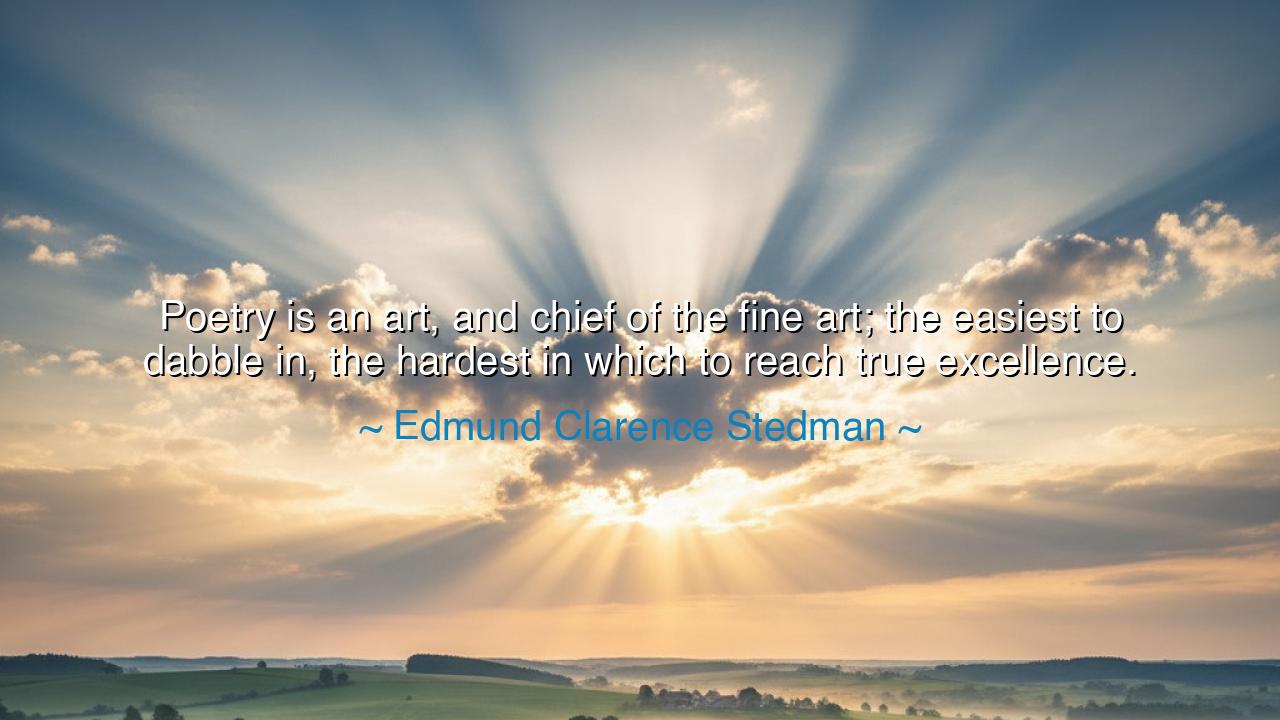
Poetry is an art, and chief of the fine art; the easiest to
Poetry is an art, and chief of the fine art; the easiest to dabble in, the hardest in which to reach true excellence.






Hear, O seekers of wisdom, the voice of Edmund Clarence Stedman, who proclaimed: “Poetry is an art, and chief of the fine arts; the easiest to dabble in, the hardest in which to reach true excellence.” In this saying, Stedman reveals a paradox that has endured across the ages: that poetry, though accessible to all, demands more of the soul than any other art if one would achieve greatness. It is both open to the child who scribbles a verse and merciless to the master who strives a lifetime for perfection.
Why is poetry called the “chief of the fine arts”? Because it is the oldest and most fundamental. Before men carved statues or painted frescoes, they spoke and sang. Poetry was the first art, the vessel by which memory, law, faith, and myth were carried. It is the parent of music, the brother of storytelling, the root of theater. Words shape thought, and poetry is language shaped into its highest form. In this sense, poetry reigns above the other arts, for it touches the core of human identity: the power to name, to sing, to remember.
Yet Stedman warns that while poetry is easy to dabble in, it is hard to master. Anyone can write a few lines, anyone can rhyme “love” with “dove,” anyone can catch a fleeting image and call it verse. This ease tempts many, but the danger is that such ease deceives. For true excellence demands more than arrangement—it demands vision, rhythm, originality, and depth. A poem that endures must speak not only with cleverness, but with the weight of truth. It is one thing to sketch a figure in sand, another to carve it in marble.
Consider John Keats, who in his short life pursued the perfection of verse with fevered devotion. Many wrote poetry in his day, but few reached the heights he attained in his Odes. Why? Because Keats gave not only words, but blood and soul; he wrestled with beauty and mortality until his lines became eternal. The ease of dabbling tempted many of his peers into forgettable verse, but excellence required Keats’s sacrifice. His greatness proves Stedman’s truth: the field of poetry is crowded, but the mountaintop is narrow.
History is filled with examples of poets who struggled toward excellence. Virgil labored for years on the Aeneid, revising and reshaping until his death. Legend says he asked for the manuscript to be burned, deeming it unfinished, though the world calls it one of the greatest works ever composed. Contrast this with the countless poets of Rome whose names are lost, their verses shallow, their dabbling forgotten. Here lies the difference: the path of excellence is hard, but it alone leads to immortality.
The reason poetry is hardest to perfect is because it calls upon the whole being of the poet. The sculptor works with marble, the painter with pigment, the musician with sound. But the poet works with language itself—the instrument of thought. Every word carries history, resonance, rhythm, and weight. To wield words carelessly is easy; to wield them with mastery, shaping not only their sound but their soul, is among the hardest of all human endeavors.
Therefore, O children of tomorrow, let this lesson be heard: do not be discouraged if your first verses are clumsy, nor deceived into thinking that ease means excellence. Poetry welcomes all to its gates, but the path beyond them is steep and narrow. If you desire greatness, walk it with patience, with humility, with devotion. Read the masters, wrestle with language, endure the silence until the right word comes.
So remember Stedman’s wisdom: poetry is indeed the chief of the fine arts. To dabble is easy, but to excel is the work of a lifetime. Do not shrink from this labor. For though the climb is hard, the summit is radiant, and the poem forged in such fire will endure beyond the poet’s days. Strive not to dabble, but to excel, and your words may live forever.






AAdministratorAdministrator
Welcome, honored guests. Please leave a comment, we will respond soon